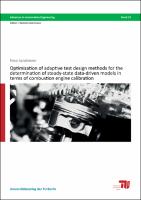Optimization of adaptive test design methods for the determination of steady-state data-driven models in terms of combustion engine calibration
| dc.contributor.author | Sandmeier, Nino | |
| dc.date.accessioned | 2022-12-12T13:22:18Z | |
| dc.date.available | 2022-12-12T13:22:18Z | |
| dc.date.issued | 2022 | |
| dc.identifier.uri | https://library.oapen.org/handle/20.500.12657/60120 | |
| dc.description.abstract | This thesis deals with the development of a model-based adaptive test design strategy with a focus on steady-state combustion engine calibration. The first research topic investigates the question how to handle limits in the input domain during an adaptive test design procedure. The second area of scope aims at identifying the test design method providing the best model quality improvement in terms of overall model prediction error. To consider restricted areas in the input domain, a convex hull-based solution involving a convex cone algorithm is developed, the outcome of which serves as a boundary model for a test point search. A solution is derived to enable the application of the boundary model to high-dimensional problems without calculating the exact convex hull and cones. Furthermore, different data-driven engine modeling methods are compared, resulting in the Gaussian process model as the most suitable one for a model-based calibration. To determine an appropriate test design method for a Gaussian process model application, two new strategies are developed and compared to state-of-the-art methods. A simulation-based study shows the most benefit applying a modified mutual information test design, followed by a newly developed relevance-based test design with less computational effort. The boundary model and the relevance-based test design are integrated into a multicriterial test design strategy that is tailored to match the requirements of combustion engine test bench measurements. A simulation-based study with seven and nine input parameters and four outputs each offered an average model quality improvement of 36 % and an average measured input area volume increase of 65 % compared to a non-adaptive space-filling test design. The multicriterial test design was applied to a test bench measurement with seven inputs for verification. Compared to a space-filling test design measurement, the improvement could be confirmed with an average model quality increase of 17 % over eight outputs and a 34 % larger measured input area. | en_US |
| dc.language | English | en_US |
| dc.relation.ispartofseries | Advances in Automation Engineering | en_US |
| dc.subject.classification | thema EDItEUR::T Technology, Engineering, Agriculture, Industrial processes::TB Technology: general issues::TBM Instruments and instrumentation::TBMM Engineering measurement and calibration | en_US |
| dc.subject.classification | thema EDItEUR::T Technology, Engineering, Agriculture, Industrial processes::TH Energy technology and engineering | en_US |
| dc.subject.other | design of experiments; adaptive test design; boundary search | en_US |
| dc.title | Optimization of adaptive test design methods for the determination of steady-state data-driven models in terms of combustion engine calibration | en_US |
| dc.type | book | |
| oapen.identifier.doi | 10.14279/depositonce-15364 | en_US |
| oapen.relation.isPublishedBy | e5e3d993-eb32-46aa-8ee9-b5f168659224 | en_US |
| oapen.relation.isbn | 9783798332478 | en_US |
| oapen.collection | AG Universitätsverlage | |
| oapen.series.number | 10 | en_US |
| oapen.pages | 236 | en_US |
| oapen.place.publication | Berlin | en_US |

